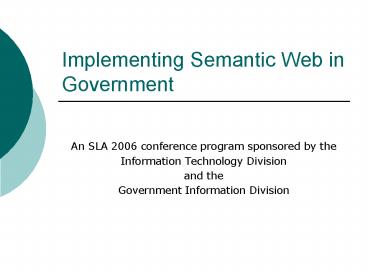Implementing Semantic Web in Government - PowerPoint PPT Presentation
1 / 11
Title:
Implementing Semantic Web in Government
Description:
Tim Berners-Lee, James Hendler, Ora Lassila in http://www.scientificamerican.com ... http://www.whitehouse.gov/omb/egov/a-5-drm.html. Data Reference Model (continued) ... – PowerPoint PPT presentation
Number of Views:17
Avg rating:3.0/5.0
Title: Implementing Semantic Web in Government
1
Implementing Semantic Web in Government
- An SLA 2006 conference program sponsored by the
- Information Technology Division
- and the
- Government Information Division
2
Program Schedule
- Overview of implementing the Semantic Web using
the Data Reference Model and the Categorization
Working Group of the Interagency Committee on
Government Information (ICGI) - Richard Huffine, U.S. General Services
Administration/FirstGov - Semantic Web in use in government - Case studies
using Federal Enterprise Architecture NASA
Digital Shuttle Project, FAA, and GSA - Dean Allemang, Top Quadrant Consulting
- Semantic interoperability and library skills
(taxonomy, metadata management, etc.) - Marjorie Hlava, Access Innovations
3
- "The Semantic Web is an extension of the current
web in which information is given well-defined
meaning, better enabling computers and people to
work in cooperation. - Tim Berners-Lee, James Hendler, Ora Lassila in
http//www.scientificamerican.com/2001/0501issue/0
501berners-lee.html
4
- The Semantic Web is a project to make the content
of the World Wide Web understandable by machines.
It extends the ability of the World Wide Web
through the use of standards, markup languages
and related processing tools. - en.wikipedia.org/wiki/Semantic_Web
5
What Is the Semantic Web?
- The Semantic Web is an extension of the current
Web that will allow you to find, share, and
combine information more easily. It relies on
machine-readable information and metadata
expressed in RDF. - www.noisebetweenstations.com/personal/essays/metad
ata_glossary/metadata_glossary.html - Resource Description Framework (RDF) is a general
framework for how to describe any Internet
resource such as a Web site and its content. - www.perfectxml.com/glossary2.asp
6
Semantic Web in Government
- Government Agencies are struggling with issues of
repetition in data collection, barriers to
sharing information, and increasing expectations
to do more with less - The U.S. E-Gov Agenda (and the Partnership for
Reinventing Government before it) sets
expectations that Agencies will work together to
solve common business problems - After September 11, 2001, the intelligence
community has stepped up their efforts to make
their information interoperable with other
intelligence and law enforcement entities
7
Categorization Working Group
- Convened in 2003 to recommend approaches for
implementing the E-Gov Act - Comprised of U.S. Federal staff, mostly
librarians - Focused on defining a clear scope and approach to
the categorization of information in order to
improve access to government information that is
born digital - Intended to build on the past (bibliographic
records) and incorporate new approached for the
future - Recommendations were rolled into the
implementation of the Data Reference Model of the
Federal Enterprise Architecture - See a video series on the topic at
http//www.loc.gov/flicc/video/cmwg/egov/egov05.ht
ml
8
Federal Enterprise Architecture
- A set of common frameworks for describing
information systems and their interdependencies - Requires Agencies and Departments to document
their current and target architectures and then
justify Information Technology expenditures in
support of achieving that target architecture - Encourages organizations to share components and
reduce the duplication of effort (through
coordinated E-Gov Initiatives like Grants, Travel
and Financial Management
9
Data Reference Model
- Version 2.0 released in November, 2005
- There are two basic types of metadata recommended
in the Data Description section of the DRM
abstract model - Logical data models to describe Structured Data
Resources, and - Digital Data Resource metadata (such as Dublin
Core elements) to describe Semi-Structured and
Unstructured Data Resources. - Recommendation stopped short of recommending
specific standards but acknowledges that various
standards can be mapped to one another to create
a minimal amount of interoperability - http//www.whitehouse.gov/omb/egov/a-5-drm.html
10
Data Reference Model (continued)
- Agency implementation of the Data Reference Model
is slow - Much of the utility of the FEA to date has been
driven by IT Investment decision-making, not by
the need to share information with other Agencies - The primary exception, intelligence, has made
real progress although much of it is classified - The Data Reference Model supports semantic
interoperability but it does not mandate its
implementation. - Agencies are still struggling with both the
business and cultural needs for sharing
information
11
In the News
- New Scientist has discovered that Pentagon's
National Security Agency, which specialises in
eavesdropping and code-breaking, is funding
research into the mass harvesting of the
information that people post about themselves on
social networks. And it could harness advances in
internet technology - specifically the
forthcoming "semantic web" championed by the web
standards organisation W3C - to combine data from
social networking websites with details such as
banking, retail and property records, allowing
the NSA to build extensive, all-embracing
personal profiles of individuals. - Pentagon sets its sights on social networking
websites, by Paul Marks, June 9, 2006,
NewScientist.com news service































